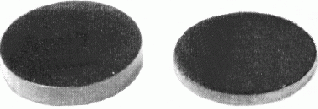SPI Supplies Pyrolytic Graphite Planchets, 25.4 mm Diameter x 1.6 mm Thick
Physical description:
Two thicknesses are available both 25.4mm diameter. Almost always reusable with proper cleaning.
1.6mm thick
The SPI Pyrolitic Graphite Planchets are a far higher quality product than "ordinary" pyrolytic graphite coatings on a more regular type of graphite substrate. While there might be some controversy as to just how really "ordered" is this material, there is no question that the slow growth in one direction and high crystallinity result in a growth situation that excludes the normal kinds of impurities typically found in more ordinary pyrolytic graphite. There is also a far higher level of "order" to the resulting material, and while it surely would not be considered "single crystal" it is far more ordered because of the almost columnar growth from a substrate.
The particular type of pyrolytic graphite offered presently by SPI Supplies is of the type that is "substrate nucleated" or sometimes referred to as "SN Grade". This is separate and distinct from another form of the product called "continuously nucleated" or "CN Grade".
Furthermore this "special unique form of" pyrolytic graphite can be diamond polished into a truly "glass-like" mirror reflective surface.
The low Bremsstrahlung background radiation alternative:
Most forms of carbon have associated with them high background radiation levels in an EDS spectra, thereby reducing the sensitivity for a high precision analysis. A good alternative would be the SPI Diamond Planchets, since carbon in the form of diamond has a very low level of Bremsstrahlung radiation, and approaches that of beryllium.
Cleaning for reuse:
We realize that these pyrolytic graphite planchets are expensive and should not be treated as a consumable. One can carefully remove the sample, and then re-polish on a standard metallographic polishing table, using diamond paste down to 1 µm diamond. If there are scratches or gouges, one might have to start with a larger size diamond paste (or slurry).

